Panasonic CF-29NTQGZBM Service Manual
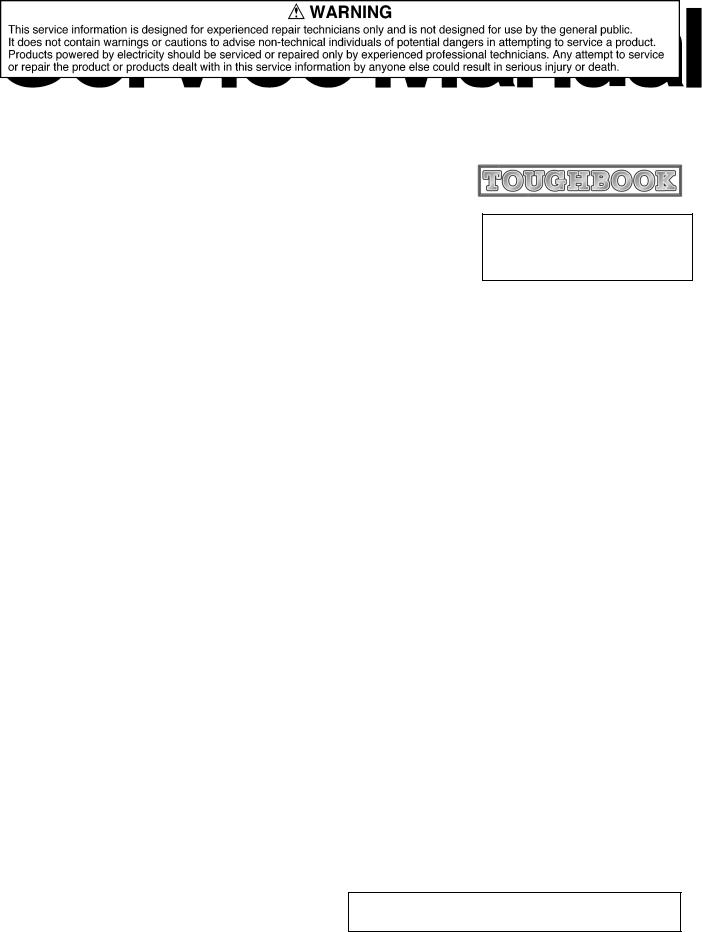
ORDER NO. CPD0604068C1
Notebook Computer
CF-29
This is the Service Manual for the following areas.
M …for U.S.A. and Canada
Model No. CF-29NTQGZBM
© 2006 Matsushita Electric Industrial Co., Ltd. All rights reserved. Unauthorized copying and distribution is a violation of law.

WARNING
For U.K.
This apparatus must be earthed for your safety.
To ensure safe operation the three-pin plug must be inserted only into a standard three-pin power point which is effectively earthed through the normal household wiring.
Extension cords used with the equipment must be three-core and be correctly wired to provide connection to earth. Wrongly wired extension cords are a major cause of fatalities.
The fact that the equipment operates satisfactorily does not imply that the power point is earthed and that the installation is completely safe.
For your safety, if you have any doubt about the effective earthing of the power point, consult a qualified electrician.
FOR YOUR SAFETY PLEASE READ THE FOLLOWING TEXT CAREFULLY
This appliance is supplied with a moulded three pin mains plug for your safety and convenience. A 3 amp fuse is fitted in this plug.
Should the fuse need to be replaced please ensure that the replacement fuse has a rating of 3 amps and that it is approved by ASTA or BSI to BS 1362.
Check for the ASTA mark  or the BSI mark
or the BSI mark  on the body of the fuse.
on the body of the fuse.
If the plug contains a removable fuse cover you must ensure that it is refitted when the fuse is replaced. If you lose the fuse cover the plug must not be used until a replacement cover is obtained.
A replacement fuse cover can be purchased from your local Panasonic Dealer.
IF THE FITTED MOULDED PLUG IS UNSUITABLE FOR THE SOCKET OUTLET IN YOUR HOME THEN THE FUSE SHOULD BE REMOVED AND THE PLUG CUT OFF AND DISPOSED OF SAFELY.
THERE IS A DANGER OF SEVERE ELECTRICAL SHOCK IF THE CUT OFF PLUG IS INSERTED INTO ANY 13 AMP SOCKET.
If a new plug is to be fitted please observe the wiring code as shown below. If in any doubt please consult a qualified electrician.
Warning: THIS APPLIANCE MUST BE EARTHED. Important
The wires in this mains lead are coloured in accordance with the following code: Green-and-yellow: Earth
Blue: |
Neutral |
Brown: |
Live |
As the colours of the wires in the mains lead of this apparatus may not correspond with the coloured markings identifying the terminals in your plug, proceed as follows:
The wire which is coloured GREEN-and-YELLOW must be connected to the terminal in the plug which is marked by the letter E or by the safety earth symbol  coloured GREEN or GREEN-and- YELLOW.
coloured GREEN or GREEN-and- YELLOW.
The wire which is coloured Blue must be connected to the terminal which is marked with the letter N or coloured BLACK.
The wire which is coloured Brown must be connected to the terminal which is marked with the letter L or coloured RED.
The mains plug on this equipment must be used to disconnect the mains power.
Please ensure that a socket outlet is available near the equipment and shall be easily accessible.

 How to replace the fuse
How to replace the fuse
Open the fuse compartment with a screwdriver and replace the fuse.
Warnings
 This equipment is not designed for connection to an IT power system.
This equipment is not designed for connection to an IT power system.
(An IT system is a system having no direct connections between live parts and Earth; the exposed-conducive- parts of the electrical installation are earthed.
An IT system is not permitted where the computer is directly connected to public supply systems in the U.K.)
 Disconnect the mains plug from the supply socket when the computer is not in use.
Disconnect the mains plug from the supply socket when the computer is not in use.
This equipment is produced to BS800/1983.
1

LASER SAFETY INFORMATION
For U.S.A.
Class 1 LASER-Product
This product is certified to comply with DHHS Rules 21 CFR Subchapter J.
This product complies with European Standard EN60825 (or IEC Publication 825)
For all areas
This equipment is classified as a class 1 level LASER product and there is no hazardous LASER radiation.
Caution:
(1)Use of controls or adjustments or performance of procedures other than those specified herein may result in hazardous radiation exposure.
(2)The drive is designed to be incorporated into a computer-based system or unit which has an enclosing cover. It should never be used as a stand alone drive.
Danger:
The serviceman should not remove the cover of drive unit and should not service because the drive unit is a nonserviceable part.
Please check DANGER label on PD-drive unit.
•Unplug the AC power cord to the equipment before opening the top cover of the drive.
When the power switch it on, do not place your eyes close to the front panel door to look into the interior of the unit.
LASER Specification
Class 1 level LASER Product
Wave Length: DVD 658±8 nm
CD 775~815 nm
Laser safety information is appropriate only when drive with laser is installed.
2
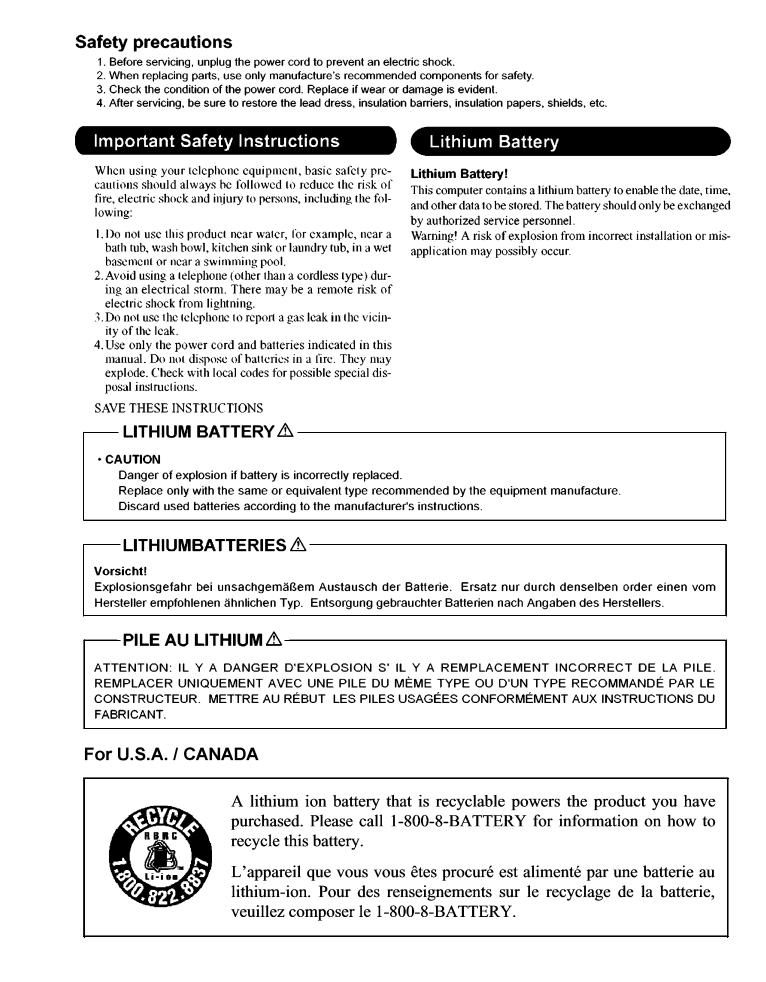
3
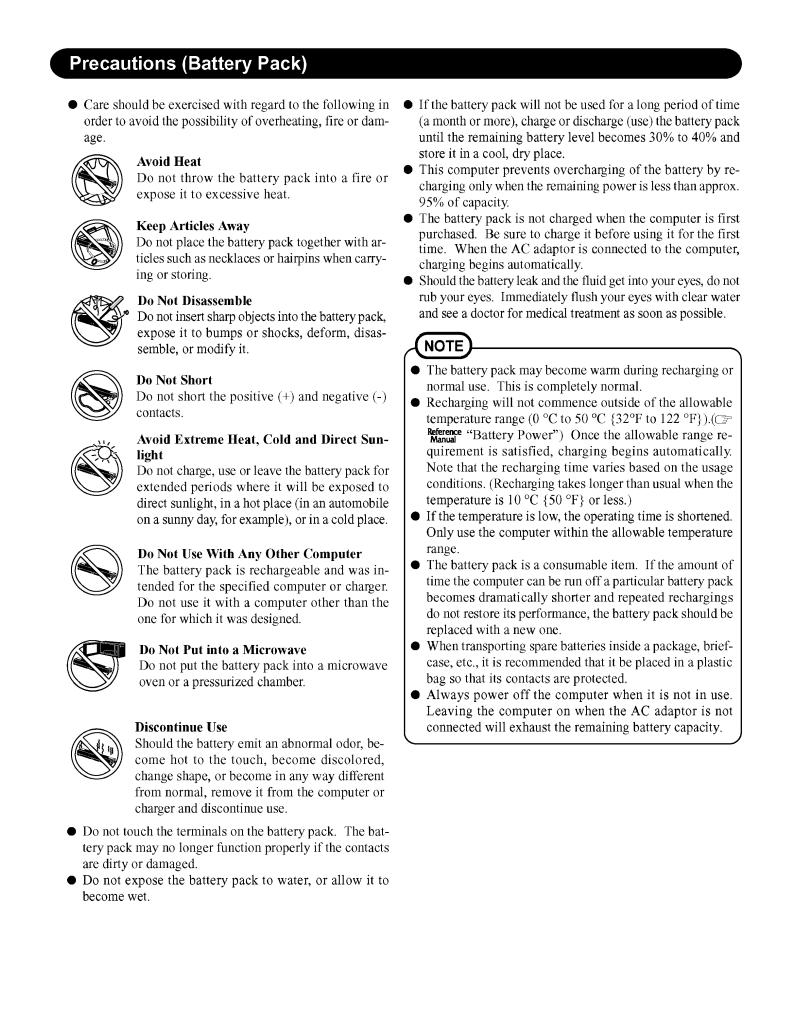
4
CONTENTS
1 Diagnosis Procedure ······································································································1-1 2 Power-On Self Test (Boot Check) ··················································································2-1 3 List of Error Codes ··········································································································3-1 4 Diagnostic Test ···············································································································4-1
5Self Diagnosis Test ·········································································································5-1
6Wiring Connection Diagram ···························································································6-1
7Disassembly/Reassembly ······························································································7-1
8Exploded View ················································································································8-1
9Replacement Parts List ··································································································9-1

1 Diagnosis Procedure
1.1. Basic Procedure
1-1
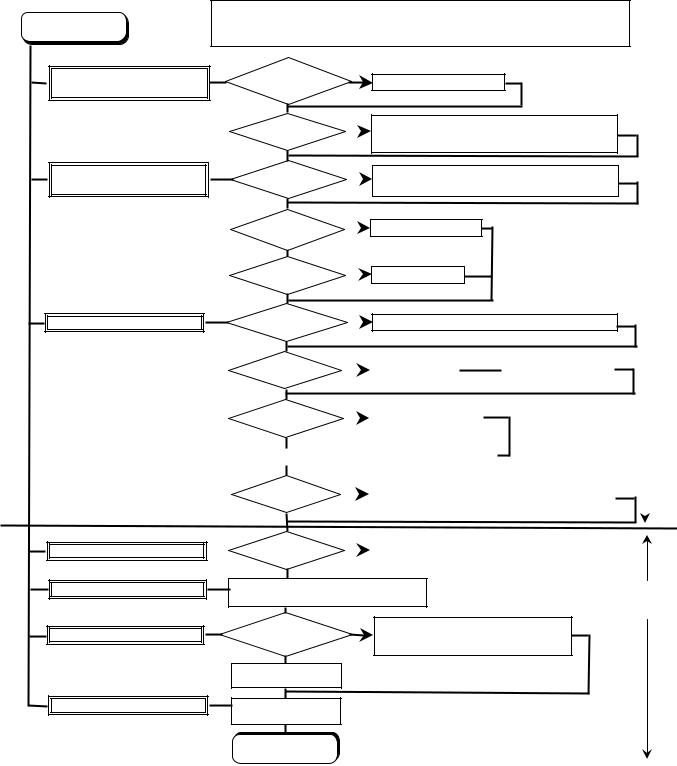
1.2. Troubleshooting
Please take note of the following two points with regard to troubleshooting:
1.Know-how of diagnosis upon occurrence of heavy troubles, e.g. ‘Set cannot be turned ON’, ‘Set fails to start’, ‘No display on screen’, etc.
2.Explanation of each trouble, mainly symptom of trouble in operation.
Flow Chart
START
Set cannot be supplied with current. Power lamp fails to light up.
Dark display on screen.
Screen fails to display.
Failure in starting
Not displayed properly on screen.
Pay attention to the following points when in pursuit of the cause of a troubleshooting.
1.Peripheral apparatus connected with the set should all be removed before operation check.
2.Make sure that cables, boards, etc. are not coming off, and recheck the contact condition.
AC NG Adaptor/Battery
Output voltage
|
OK |
|
|
|
|
Power lamp |
|
NO |
|||
check |
YES |
||||
|
|||||
Inverter board |
|
NG |
|||
|
OK |
|
|
|
|
LCD back |
|
NO |
|||
light lighting |
|
|
|
|
|
YES |
NG |
||||
LCD unit |
|
||||
|
|
|
|
|
|
check |
|
|
|
|
|
OK |
|
|
|
|
|
BIOS operation |
|
NO |
|||
check |
|
|
|
|
|
YES |
|||||
Result of |
NG |
|
|||
POST |
OK |
|
|
|
|
|
|
|
|
|
|
Replace AC Adaptor/Battery
Check contact condition of power input terminal. Replace if defective.
Check Power SW. Replace if defective.
Replace inverter board.
Check inverter cable continuity. Replace if defective
Replace LCD back light.
Replace LCD unit.
Replace main board (Check fuse at power source).
Refer to POST |
|
|
|
Replace main board. |
|
error code table. |
|
|
|
|
|
|
|
|
|
|
NG |
|
|
|
|
|
||||
|
|
Set-up utility |
|
|
|
Heavy trouble e.g., |
||||||
|
Replace main board. |
|
|
|||||||||
|
|
starting |
|
|
|
|
|
|
‘Set cannot be turned |
|||
|
|
|
|
|
|
|
|
|
||||
|
|
|
|
|
|
|
|
|||||
|
|
OK |
|
|
|
|
|
|
|
ON’, ‘Set fails to start’, |
||
|
|
|
|
|
|
|
|
|
‘No display on |
|||
|
|
Return set-up utility setpoint to the state of ‘delivery from factory’. |
|
screen’, etc. |
|
|||||||
|
|
|
|
|
|
|
|
|
|
|
|
|
|
|
|
NO |
Check HDD cable connection and continuity. |
|
|
|
|||||
|
|
HDD access |
Replace if defective. |
|
|
|
||||||
|
|
|
|
|
|
|
|
|
||||
|
|
|
|
|
|
Replace HDD & Reinstall. |
|
|
|
|||
|
|
YES |
|
|
|
|
|
|
|
|||
|
|
|
|
|
|
Replace main board. |
|
|
|
|||
|
|
|
|
|
|
|
|
|
||||
|
|
Main board |
NG |
|
|
|
|
|
|
|||
|
|
Replace main board |
|
|
|
|
|
|||||
|
|
check |
|
|
|
|
|
|
|
|
|
|
Some or all keys cannot be input.
DVD/CD CALL not practicable.
*Clean DVD-ROM drive with an applicator.
Starts but operates unstably.
OK
Make sure of contact of K/B connector in use.
Replace keyboard or main board.
Trouble |
NO |
Check if there are any flaws on DVD or CD |
symptoms on some |
|
media. Since flaws may appear on specific |
of DVD or CD |
|
media, DVD or CD media can be defective. |
YES
Replace DVD drive.
Replace main board.
Reinstall HDD.
Replace main board.
STARTEND
Each kind of trouble in operation.
1-2

2 Power-On Self Test (Boot Check)
Outline of POST
The set has a boot check function called POST (Power-On Self Test) in it. The condition of the main body is diagnosed by checking beep sound or error code.
 Start .............Test begins automatically when power switch is set to ON.
Start .............Test begins automatically when power switch is set to ON.
 Normal finish .....After memory checking, a beep sound is issued once and the set is placed into automatic stop. Note: If no error occurs, nothing is displayed. (No display of OK, etc.)
Normal finish .....After memory checking, a beep sound is issued once and the set is placed into automatic stop. Note: If no error occurs, nothing is displayed. (No display of OK, etc.)
Error Diagnosis by Checking Beep Signal Sound
The beep sound is as follows: |
|
|
|
|
|
|
|
|
|
|
|
|
|
|
|
|
|
|
||||||||||||
|
|
|
|
|
|
|
|
|
|
|
|
|
|
|
|
|
|
|
|
|
|
|
|
|
|
|
|
|
|
(1 (long sound) -2-3-4) |
|
|
|
|
|
|
|
|
|
|
|
|
|
|
|
|
|
|
|
|
|
|
|
|
|
|
|
|
|
|
|
|
|
|
|
|
|
|
|
|
|
|
|
|
|
|
|
|
|
|
|
|
|
|
|
|
|
|
|
|
|
|
|
|
(Length of bar shows length of sound.) |
|
|
|
|
|
|
|
|
|
|
|
|
|
|
|
|||||||||||||
|
|
= long sound (about 0.4 sec.), |
|
= short sound (about 0.2 sec.), Length between sounds is about 0.1 sec. |
||||||||||||||||||||||||||
|
|
|
||||||||||||||||||||||||||||
Table of errors classified by beep sounds |
|
|
|
|
|
|
|
|
|
|
|
|
|
|
|
|
|
|
||||||||||||
|
|
|
|
|
|
|
|
|
|
|
|
|
|
|
|
|
|
|
|
|
||||||||||
|
Diagnosis |
|
|
|
Beep signal sound |
|
|
|
|
|
|
|
|
|
|
|
|
|
|
Error message |
||||||||||
|
Main board |
|
|
|
1(long sound)-2 |
|
|
|
|
|
BIOS ROM error |
|||||||||||||||||||
|
|
|
|
|
|
1-2-2-3 |
|
|
|
|
|
|
|
|
|
BIOS ROM error |
||||||||||||||
|
|
|
|
|
|
1-3-1-1 |
|
|
|
|
|
|
|
|
|
RAM error |
||||||||||||||
|
|
|
|
|
|
1-3-1-3 |
|
|
|
|
|
|
|
|
|
Keyboard controller error |
||||||||||||||
|
|
|
|
|
|
1-3-4-1 |
|
|
|
|
|
|
|
|
|
RAM error |
||||||||||||||
|
|
|
|
|
|
1-3-4-3 |
|
|
|
|
|
|
|
|
|
RAM error |
||||||||||||||
|
|
|
|
|
|
1-4-1-1 |
|
|
|
|
|
|
|
|
|
RAM error |
||||||||||||||
|
|
|
|
|
|
2-1-2-3 |
|
|
|
|
|
|
|
|
|
BIOS ROM error |
||||||||||||||
|
|
|
|
|
|
2-2-3-1 |
|
|
|
|
|
|
|
|
|
Occurrence of unexpected offering |
||||||||||||||
(Note) A beep sound is also issued in case of other I/O trouble.
2-1
3. Listof Error Codes <Only when the port replicator is connected>
The following is a list of the messages that BIOS can display. Most of them occur during POST. Some of them display information about a hardware device, e.g., the amount of memory installed. Others may indicate a problem with a device, such as the way it has been configured.
Following the list are explanations of the messages and remedies for reported problems.
If your system displays one of except the messages marked below with an asterisk (*), write down the message and contact Panasonic Technical Support. If your system fails after you make changes in the Setup menus, reset the computer, enter Setup and install Setup defaults or correct the error.
0200 Failure Fixed Disk
Fixed disk in not working or not configured properly. Check to see if fixed disk is attached properly. Run Setup. Find out if the fixed-disk type is correctly identified.
0210 Stuck key
Stuck key on keyboard.
0211 Keyboard error
Keyboard not working.
0212 Keyboard Controller Failed
Keyboard controller failed test. May require replacing keyboard controller.
0213 Keyboard locked - Unlock key switch
Unlock the system to proceed.
0230 System RAM Failed at offset: nnnn
System RAM failed at offset nnnn of in the 64k block at which the error was detected.
0231 Shadow RAM Failed at offset: nnnn
Shadow RAM failed at offset nnnn of the 64k block at which the error was detected.
0232 Extended RAM Failed at offset: nnnn
Extended memory not working or not configured properly at offset nnnn.
0250 System battery is dead - Replace and run SETUP
The CMOS clock battery indicator shows the battery is dead. Replace the battery and run Setup to reconfigure the system.
*0251 System CMOS checksum bad - Default configuration used
System CMOS has been corrupted or modified incorrectly, perhaps by an application program that changes data stored in CMOS. The BIOS installed Default SETUP Values.
If you do not want these values, enter Setup and enter your own values. If the error persists, check the system battery or contact Panasonic Technical Support.
0260 System timer error
The timer test failed. Requires repair of system board.
0270 Real time clock error
Real-time clock fails BIOS test. May require board repair.
*0280 Previous boot incomplete - Default configuration used
Previous POST did not complete successfully. POST loads default values and offers to run Setup. If the failure was caused by incorrect values and they are not corrected, the next boot will likely fail. On systems with control of wait states, improper Setup settings can also
terminate |
POST and cause this error on the next boot. Run Setup and verify that the |
wait-state |
configuration is correct. This error is cleared the next time the system is booted. |
0281 Memory Size found by POST differed from EISA CMOS
Memory size found by POST differed from EISA CMOS.
3-1
02D0 System cache error - Cache disabled
Contact Panasonic Technical Support.
02F0: CPU ID:
CPU socket number for Multi-Processor error.
02F4: EISA CMOS not writable
ServerBIOS2 test error: Cannot write to EISA CMOS.
02F5: DMA Test Failed
ServerBIOS2 test error: Cannot write to extended DMA (Direct Memory Access) registers.
02F6: Software NMI Failed
ServerBIOS2 test error: Cannot generate software NMI (Non-Maskable Interrupt).
02F7: Fail - Safe Timer NMI Failed
ServerBIOS2 test error: Fail-Safe Timer takes too long. device address Conflict
Address conflict for specified device.
Allocation Error for: device
Run ISA or EISA Configuration Utility to resolve resource conflict for the specified device.
Failing Bits: nnnn
The hex number nnnn is a map of the bits at the RAM address which failed the memory test. Each 1 (one) in the map indicates a failed bit. See error 230,231 or 232 for offset address of the failure in System, Extended or Shadow memory.
Invalid System Configuration Data
Problem with NVRAM (CMOS) data.
I/O device IRQ conflict
I/O device IRQ conflict error.
Operating System not found
Operating system cannot be located on either drive A: or drive C: Enter Setup and see if fixed disk and drive A: are properly identified.
Parity Check 1 nnnn
Parity error found in the system bus. BIOS attempts to locate the address and display it on the screen. If it cannot locate the address, it displays ????. Parity is a method for checking errors in binary data. A parity error indicates that some data has been corrupted.
Parity Check 2 nnnn
Parity error found in the I/O bus. BIOS attempts to locate the address and display it on the screen. If it cannot locate the address, it displays ????.
Press <F1> to resume, <F2> to Setup
Displayed after any recoverable error message. Press <F1> to start the boot process or <F2> to enter a Setup and change the settings. Write down and follow the information shown on the screen.
3-2
4.Diagnostic Test
4.1Equipment
(1)Test Computer ································································································ 1 unit
(2)AC Adapter ····································································································· 1 pc.
(3)External Printer ······························································································· 1 unit
(4) |
Loopback Plug (Parallel Port Test) [ P/N: DFWV95C0081 ] ··························· |
1 pc. |
(5) |
Loopback Plug (Serial Port Test for RS232C) [ P/N: DFWV95C0067 ] ········· |
1 pc. |
(6) |
Floppy Disk containg file DIAG ······································································· |
1 pc. |
4.2Preparation
(1)Connect the AC Adapter and External Printer to the computer.
(2)The System Setup should be set to the factory setting values by executing the “SETUP UTILITY” which can be invoked by F2 key at the POST.
If not, the messages and items of the diagnostic test may not be displayed properly on the LCD.
(3)The serial port must be enabled in the “SETUP UTILITY” in order to execute the “1st SERIAL PORT” test.
(4)Connect the serial loopback plug.
(5)In order to test the parallel port with Loopback Plug, disconnect the printer cable and connect the parallel loopback plug with Power OFF.
4.3NOTICE
When “Enter password” is displayed, use “Password Skipping Plug” in order to skip the user password.
1)Connect the parallel plug to the parallel port.
2)Connect the PS/2 mouse plug to the mouse port
3)Power on the computer.
The wiring of the parallel plug is described below.
Connect pins 2-5-6-8-11-13-15-18-19-20-21-22-23 to Shield GND (PS/2 mouse plug pin3). Connect pins 3-4-7-9-10-12 to VC5 (PS/2 mouse plug pin4) with 4.7KW each.
CAUTION
The plug described above must be used for servicing purpose only.
Do not use it for other than the above purpose and ensure that it remains confidential. Using the plug enables the user to skip the previous password and disable the password.
4-1

5 Self Diagnosis Test
1.Floppy disk is included for the self-diagnostic tests that should be performed before using this product.
2.Connect External Floppy Disk Drive (FDD) to USB port for diagnosis test.
Important notice
System password
This product has a password function. If this function is turned on, the self-diagnostics tests will not work. You will need ask the user for the password before performing the self-diagnostics.
5.1. Outline of Self Diagnostic Tests
Insert the diagnostics floppy disk
Return the setup contents to default
 Starting up the setup utility
Starting up the setup utility
Turn on the power.
 When "Panasonic Press F2 to enter setup" appears on the screen, press F2.
When "Panasonic Press F2 to enter setup" appears on the screen, press F2.
 Press "
Press " " to select [ Exit ]
" to select [ Exit ]
Press "  " to select [ Get default value ]
" to select [ Get default value ]
Press Enter.
 Choose Yes for "Load default Configuration now?"
Choose Yes for "Load default Configuration now?"  Select "Save Values & Exit" and press Enter.
Select "Save Values & Exit" and press Enter.
Choose Yes for "Save Configuration changes and exit now?" and press Enter.
Choose test from the menu screen to start the test.
Caution:
After completing repairs, be sure to carry out the Automatic test and Peripheraltest.
 Menu Screen
Menu Screen
1.DIAG on FD
2.LAN test
3.Modem test
4.Wireless LAN test (Wireless LAN Model only)
5.CD test
Q. Quit
<Automatic test> |
<Peripheral test> |
<Test selection> |
Tests selected (O) from the test |
The parallel devices can be tested. |
Specifc tests required can |
item list will be performed in |
|
be freely selected and |
succession. |
2. LAN test |
performed from the test item |
1. DIAG on FD |
3. Modem test |
list. |
4. Wireless LAN test |
Be sure to carry out the Selection |
|
|
(Wireless LAN Model only) |
|
|
5. CD test |
test only when necessary. |
Problems in the unit are located and divided according to error messages that occur during testing.
5-1
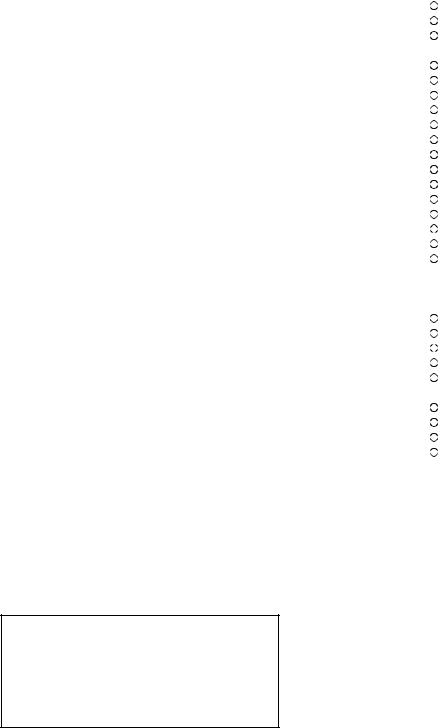
5.1.1. List of main test items
The selection item displays the items selected under Automatic test. If you select Automatic test, these test items will be performed automatically. You can use Selection test to choose items from the menu screen that you want to have tested.
These items are shown below.
|
Test classification |
Test items shown on the screen |
Contents |
Select |
||
1 |
|
SPEAKER TEST |
Speaker test |
|
|
|
2 |
|
VESA MODE TEST |
VESA mode test |
|
|
|
3 |
CPU |
A20 GATE TEST |
Address A20 line |
|
|
|
4 |
(CPU related) |
CACHE ON/OFF TEST |
Cache memory on/off test |
|
|
|
|
|
|
||||
5 |
|
NPU OPERAND TEST |
Floating point processor function test |
|
|
|
6 |
RAM (Memory related) |
RAM STANDARD TEST |
Memory standard test |
|
|
|
7 |
CONTROL |
DMA PAGE REG TEST |
DMA page register test |
|
|
|
8 |
(Control ICs on the main |
DMA REGISTER TEST |
DAM register test |
|
|
|
9 |
board, etc.) |
DMAC TRANSFER TEST |
DAM transfer test |
|
|
|
10 |
|
PIC HALT INSTRUCTION TEST |
Interrupt controller halt instruction test |
|
|
|
11 |
|
PIC REGISTER TEST |
Interrupt controller register test |
|
|
|
12 |
|
RTC CMOS RAM TEST |
Real time clock CMOS test |
|
|
|
13 |
|
RTC TEST |
Real time clock test |
|
|
|
14 |
|
PIT CH0 TEST |
interrupt timer CH0 |
|
|
|
15 |
|
PIT CH1 TEST |
interrupt timer CH1 |
|
|
|
16 |
|
PIT CH2 TEST |
interrupt timer CH2 |
|
|
|
17 |
IO |
KEYBOARD REG TEST |
Keyboard test |
|
|
|
18 |
(Input-output) |
PS/2 MOUSE REG |
Mouse registration test |
|
|
|
19 |
COMMUNICATION |
SERIAL WRAP TEST |
Serial loop back (jig required) |
|
|
|
|
|
|
||||
20 |
|
SERIAL ALL INTERNAL TEST |
Serial port interior test |
|
|
|
|
|
|
|
|||
21 |
|
PARALLEL REGISTER R/W |
Parallel register R/W test |
|
|
|
|
|
|
|
|||
22 |
AUX |
PCIC ALL TEST |
PCIC test |
|
|
|
23 |
(Auxiliary functions) |
Card Bus Reg |
Card Bus register test |
|
|
|
24 |
|
USB Reg |
USB register test |
|
|
|
25 |
VIDEO |
VGA ALL TEST |
VGA test |
|
|
|
26 |
(Display related) |
SVGA RAM TEST |
SVGA RAM test |
|
|
|
27 |
DISK |
FD WT/RD/WP TEST |
FD WT, RD WP test |
|
|
|
|
|
|
||||
28 |
(FDD, HDD) |
HDD ALL TEST |
Only HDD lead test selected |
|
|
|
29 |
UNIQUE |
ECP REGISTER R/W |
ECP register R/W test |
|
|
|
30 |
(Individual functions) |
EPP REGISTER R/W |
EPP register R/W test |
|
|
|
31 |
|
EXT. CMOS R/W TEST |
Extension CMOS R/W test |
|
|
|
|
|
|
|
|
|
|
|
Test function settings |
Test condition save/play |
Following file command |
|
|
|
|
|
Test automatic execute |
Test executed on run settings by selecting command |
|||
|
|
Error display (Paging style) |
Select displayed items Error, Log, Option |
|
|
|
5.2. Automatic Test
Test execution
From the menu screen shown below For Celeron models Select and press Enter for DIAG on FD
1.DIAG on FD
2.LAN test
3.Modem test
4.Wireless LAN test (Wireless LAN Model only)
5.CD testQ. Quit
menu screen
5-2
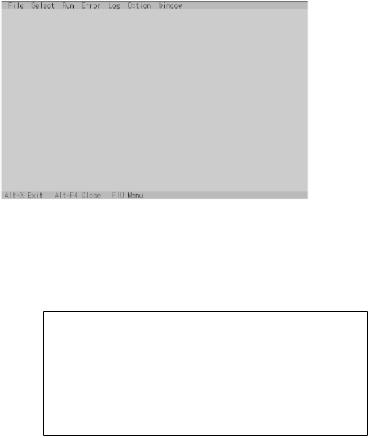
Speaker test, VESA test
The speaker test involves listening to music and choosing OK or Not okay. The VESA test involves looking at the display to see if it is satisfactory then choosing OK or Not okay.
Serial loop back test
The Automatic test’s initial settings are set so that the serial loop back test will be executed. Connect the serial loop back jig and then perform the test.
(This test is not executed on default mode)
Diagnostics result
If no errors occur. The screen shows the word "Pass" in large letters.
If errors occur. The test is stopped when an error occurs and the error message is displayed. For explanations of error messages, see Error Messages and Problem Categories (section 5.5).
Quitting the test
At the screen shown below, simultaneously press the ALT and X keys.
Input screen
5.3. Peripheral Test
Test execution
From the menu screen shown below, be sure to choose the following items and press Enter.
1.DIAG on FD
2.LAN test
3.Modem Test
4.Wireless LAN test (Wireless LAN Model only)
5.CD test
Q. Quit
menu screen
2. LAN Test
This test checks for internal LAN device. Choose LAN test and press Enter.
3.Modem Test
4.Wireless LAN Test
5.CD Test
5-3

5.4. Test Selection
Starting up the input menu
1.From the menu screen shown below, choose Quit and press Enter.
1.DIAG on FD
2.LAN test
3.Modem test
4.Wireless LAN test (Wireless LAN Model only)
5.CD testQ. Quit
menu screen
2.When A: \DIAG appears, input "JDG_295, XEX" and press Enter.
3.The input screen shown below will appear.
To choose menu items, hold down "ALT" and press the selection key.
Example:
"ALT" + F brings up the File menu.
Input screen
Order of test flow selection
Input screen startup
1.Reading the test conditions settings file Press "ALT" and "F".
Press "L".
Press "ALT" and "O". Press Enter.
If the test condition settings file is not read, this means
the test program is not running correctly.
2. setting the test items |
[ Saving selected test items ] |
|
Press "ALT" and "S". |
||
Press "S". |
If you change the file name when |
|
Choose the test item and press Enter. |
saving the file in step , you can |
|
Choose the test whose settings are- |
create test condition settings for |
|
to be changed, press "A" for Additional- |
custom test items. |
|
and "R" for Erase. |
Example: |
|
All initial VAlues are "0" so set |
CF-29. * * * |
TEST1. * * * |
tests other than the necessary ones to "1". Press "O" twice to return the menu screen.
To save the selected list, press "ALT" and "F" at the file menu.
 Starting the test
Starting the test
Press "ALT" and "R".
Press "R".
This will start the test.
End of test
5-4
5.5. Error Messages and Troubleshooting
The table below explains the parts that may be faulty or damaged should an error message occur while performing the various test items of the self diagnostics program.
|
Test classification |
Screen display test items |
Contents |
1 |
CPU |
A20 GATE TEST |
Address 20 line |
2 |
(CPU related) |
CACHE ON/OFF |
Cache memory on/off |
3 |
|
NPU OPERAND TEST |
Floating point processor function |
4 |
RAM (Memory related) |
RAM STANDARD |
Memory standard |
5 |
CONTROL |
DMA PAGE REG TEST |
DMA page register |
6 |
(Control ICs on the |
DMA REGISTER TEST |
DAM register |
7 |
main board, etc.) |
DMAC Transfer TEST |
DAM transfer test |
8 |
|
PIC HALT INSTRUCTION TEST |
Interrupt controller |
9 |
|
PIC REGISTER TEST |
Interrupt controller |
10 |
|
RTC CMOS RAM TEST |
Real time clock CMOS |
11 |
|
|
|
12 |
|
SPEAKER TEST |
Speaker |
13 |
|
PIT CH0 TEST |
Interrupt timer CH0 |
14 |
|
PIT CH1 TEST |
Interrupt timer CH1 |
15 |
|
PIT CH2 TEST |
Interrupt timer CH2 |
16 |
IO |
KEYBOARD REG TEST |
Keyboard |
17 |
(Input-output) |
PS/2 MOUSE REG |
Mouse |
18 |
COMMUNICATION |
SERIAL WRAP TEST |
Serial loop back (jig required) |
19 |
|
SERIAL ALL INTERNAL TEST |
Serial port |
20 |
|
PARALLEL REGISTER R/W |
Parallel register |
21 |
AUX |
PCIC ALL TEST |
PCIC |
(Auxiliary functions) |
Card Bus REG |
Card Bus port |
|
|
|
USB REG |
USB port |
22 |
VIDEO |
VGA ALL TEST |
VGA |
23 |
(Display related) |
SVGA RAM TEST |
SVGA RAM |
24 |
|
VESA MODE TEST |
VESA mode |
25 |
DISK |
FD WT/RD/WP TEST |
FD write/read/write protection |
26 |
(FDD, HDD) |
HDD ALL TEST |
Only HDD lead selected |
27 |
UNIQUE |
ECP REGISTER R/W |
Parallel port |
28 |
(Individual functions) |
EPP REGISTER R/W |
Parallel port |
29 |
|
EXT. CMOS R/W TEST |
Extension CMOS R/W test |
5-4
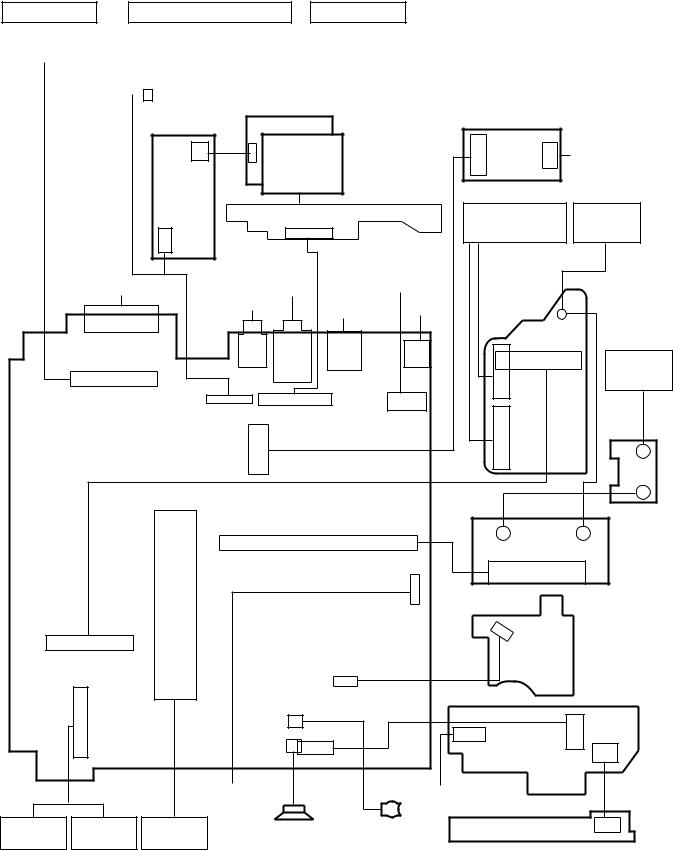
6 Wiring Connection Diagram
SERIAL PORT |
PARALLEL PORT |
|
|
EXTERNAL DISPLAY PORT |
||||||||
|
|
|
|
|
|
|
|
|
|
|
|
|
CN704 |
|
|
|
CN703 |
|
|
|
CN702 |
|
|||
IO PCB |
|
|
|
|
|
|
|
|
|
|
|
|
|
|
|
CN700 |
|
|
|
|
|
||||
|
|
|
|
|
|
|
|
|
|
|||
|
|
|
INVERTER PCB |
|
|
|
|
|
||||
|
|
|
|
CN1 CN2 |
|
|
|
BACK LIGHT |
|
|||
|
|
|
|
|
|
|
|
|
||||
|
|
|
|
|
|
|
|
|
||||
|
|
|
|
|
|
|
|
|
|
|
|
|
|
|
|
|
|
|
|
|
|
|
|
|
|
|
|
|
TOUCH SCREEN |
|
|
MDC MODEM |
|
|
|
|
|
|
|
LCD |
|
|
|
|
MODEM |
|
|
CN850 |
|
|
|
J2 |
|
PORT |
|
|
|
|
|
|
|
J1 |
|
|
|
|
|
TS PCB |
|
|
|
|
|
|
ANTENNA |
|
|
|
|
CN1 |
|
|
KEYBOARD |
|
|
|
|
CN851 |
|
|
|
|
|
|
PCB |
|
|
|
|
|
|
|
|
|
|
|
PORT-REPLICATOR |
MIC |
|
USB |
CN950 |
|
|
||
|
USB |
PORT |
(FRONT SIDE) |
|
CN952 |
||||
|
|
HEADPHON |
|
|
|
|
|||
|
|
|
DC-IN |
|
|
(REVERSE SIDE) |
|||
|
|
|
|
|
PORT |
|
|
|
|
|
CN13 |
|
JK2 |
|
|
|
KBD PCB |
||
|
|
|
JK1 |
CN55 |
JK3 |
|
|
|
|
|
|
|
|
CN930 |
|
ANTENNA |
|||
|
|
|
|
|
|
|
|||
|
|
|
|
|
|
|
|
||
|
|
|
|
|
|
|
CN933 |
|
PCB |
|
|
|
|
|
|
|
|
|
|
|
CN10 |
|
|
|
|
CN15 |
|
|
|
|
|
CN9 |
|
CN6 |
|
|
|
|
|
|
|
|
|
|
|
|
|
||
|
MAINP PCB |
CN32 |
|
|
|
|
CN932 |
|
|
|
|
|
|
|
|
|
|
|
|
|
|
|
|
|
|
|
|
|
CN1 |
|
|
|
|
|
|
|
|
|
CN2 |
|
|
|
|
|
|
|
|
|
EXT ANT. |
|
|
|
|
|
|
|
J5 |
J6 |
PCB |
|
|
|
|
CN30 |
|
|
|||
|
|
|
|
|
W-LAN MODULE |
||||
|
|
|
|
|
|
|
|||
|
|
|
|
|
|
|
|
|
J1 |
|
|
|
|
|
|
CN51 |
|
|
|
|
|
CN8 |
|
|
|
|
|
|
|
|
|
|
|
|
|
|
CN2 |
|
|
|
CN48 |
|
|
|
|
|
|
|
|
|
|
|
|
|
CN56 |
|
SD PCB |
|
|
|
|
|
|
|
|
|
|
|
|
|
CN1 |
|
|
|
|
|
|
|
|
|
|
|
|
CN4 |
|
|
|
|
CN800 |
|
|
|
|
|
|
|
|
|
|
|
|
|
CN12 |
|
|
|
CN801 |
|
CN803 |
|
|
|
CN47 |
|
|
|
|
||
|
|
|
|
|
|
|
|
||
|
|
|
|
|
|
|
|
|
|
|
|
|
|
|
|
|
TP PCB |
|
|
|
|
LAN PORT |
|
|
TOUCH PAD |
|
|
||
MAIN |
HDD |
PCMCIA |
SPEAKER |
|
RTC |
LED PCB |
CN980 |
||
|
|
|
|||||||
BUTTERY |
|
|
|
|
|
BATTERY |
|
|
|
|
|
|
|
|
6-1 |
|
|
|
|
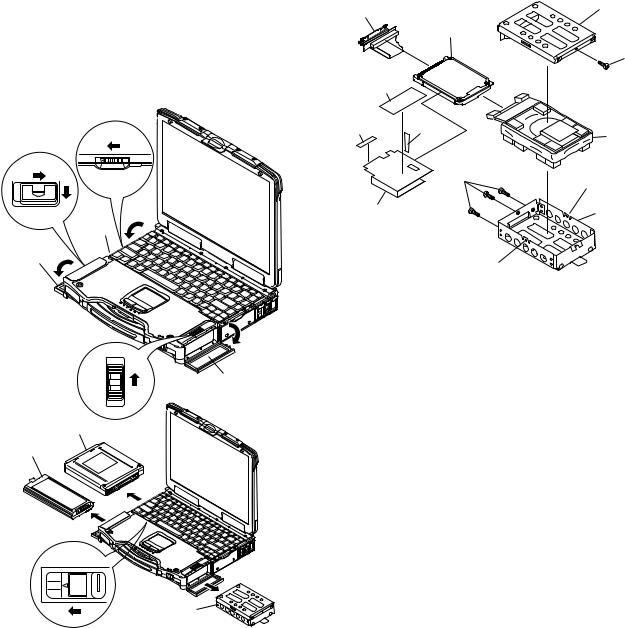
7 Disassembly/Reassembly
Note:
Power off the computer. Do not shut down to the Suspend or hibernation mode.
Do not add peripherals while the computer is in the Suspend or hibernation mode; abnormal operation may result.
7.1.Disassembly Instructions
7.1.1.Preparation
Before disassembling, be sure to make the following preparations.
•Shut down Windows and turn off the power.
•Disconnect the AC adaptor.
•Remove the optional DIMM memory card and PCMCIA card if they are connected.
•Remove other devices if they are connected.
Attention:
•Please execute writing BIOS ID when you exchange the Main Board.
•You cannot reuse the Conductive Clothes and the heat dissipating parts such as Sheet and Rubber. Use new parts.
7.1.2.Removing the Battery Pack, HDD Pack and FDD Pack
MP
Cover
Battery
Cover
HDD Cover
FDD Pack
Battery Pack
1.Open the Battery Cover.
2.Remove the Battery Pack.
3.Open the HDD Cover.
4.Remove the HDD Pack.
5.Open the FDD Cover.
6.Remove the FDD Pack. Use the MP Eject Lever.
7.1.3.Removing the HDD
HDD FPC |
HDD U Case Ass’y |
|
HDD
<A>
Heater Sheet
Sheet |
Sheet |
|
HDD |
|
|
|
|
|
|
|
Damper |
|
|
|
Ass’y |
|
|
<A> |
Tab |
|
|
|
|
Heater |
|
|
HDD Case |
|
|
|
Ass’y |
Tab
1.Remove the four Screws<A>.
2.Release the two Tabs, and remove the HDD U Case Ass’y and the HDD L Case Ass’y.
3.Remove the HDD Damper Ass’y.
4.Remove the two Sheets.
5.Remove the Heater and the Heater Sheet.
6.Remove the HDD FPC.
Screws <A>: DFHE5025XA
 MP RELEASE
MP RELEASE
HDD Pack
Figure 1
7-1
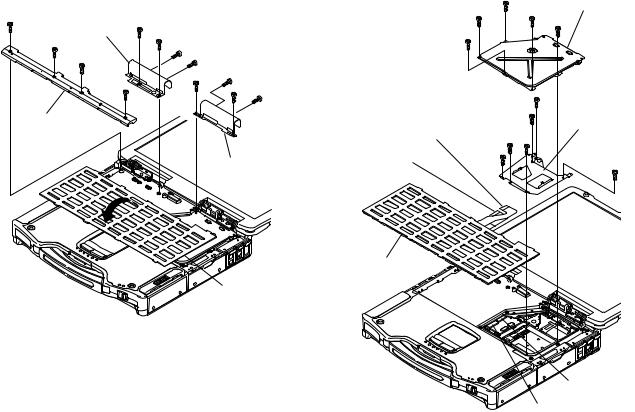
7.1.4.Removing the KB Cover, Hinge Cover L, Hinge Cover R and Keyboard
<B> |
<D> |
|
Hinge Cover L |
|
|
<B> |
<D> |
|
<C> |
|
|
<B> |
<C> |
|
|
|
|
|
<D> |
<C> |
<B> |
|
<D> <C> |
KB Cover |
|
|
|
Hinge Cover R |
|
Keyboard
Figure 3
1.Remove the four Screws<B>, and remove the KB Cover.
2.Remove the four Screws<C> and the four Screws<D>, and remove Hinge Cover L,R.
3.Remove the Keyboard.
Screws <B>: DRQT26+D4FZL
Screws <C>: DFHE5054XA
Screws <D>: DFHE5054XA
7.1.5.Remove the KB Cable Cover, Keyboard and PCMCIA Protector
|
<F> |
KB Cable Cover |
|
|
<F> |
<F> |
|
|
<F> |
||
|
<F> |
|
|
|
|
|
|
|
|
<G> |
|
to Connector |
|
<G> |
PCMCIA |
|
|
Protector |
|
(CN933) |
<G> |
<G> |
|
to Connector |
|
||
<G> |
|
|
|
(CN932) |
|
<G> |
|
Keyboard
Connector (CN933)
Connector (CN932)
Figure 4
1.Remove the five Screws<F>, and remove the KB Cable Cover.
2.Disconnect the two Cables from two Connectors (CN932, CN933)
3.Remove the six Screws<G>, and remove the PCMCIA Protector.
Screws <F>: DRHM0002ZA
Screws <G>: DRQT2+I35FKL
7-2
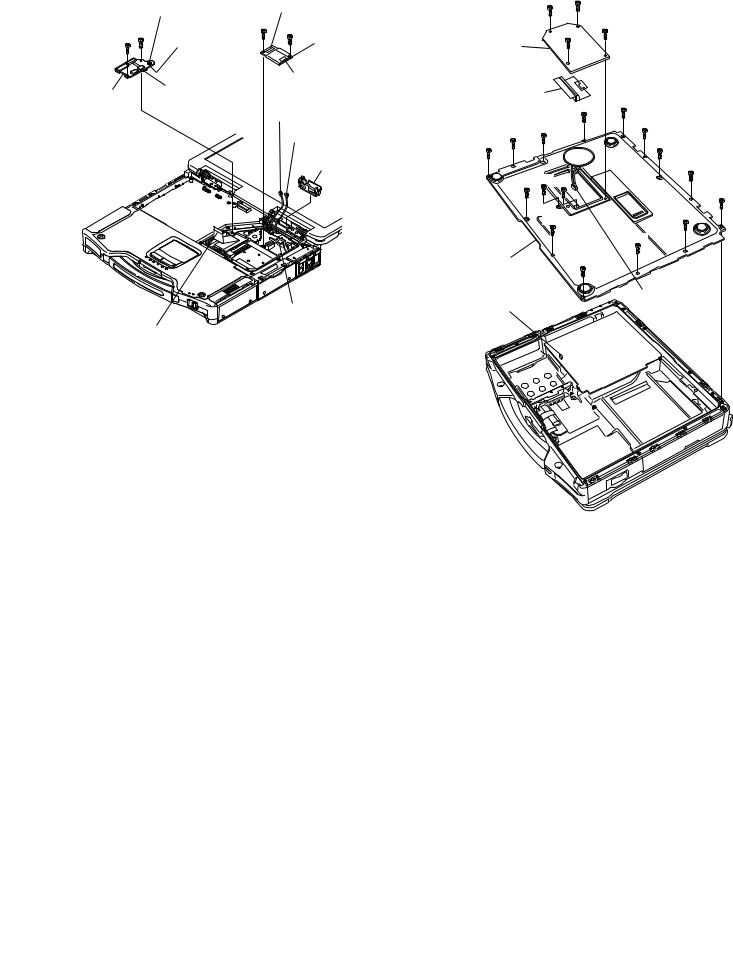
7.1.6.Removing the KBD PCB, MDC 7.1.7. Removing the DIMM Cover and
Modem and LCD Cable/MIC Frame |
Bottom Cover |
|
Connector CN950 |
Connector J1 |
||
|
(reverse side) |
|||
|
(front side) |
<I> |
|
|
|
<H> |
Connector CN952 |
<I> MDC |
|
<H> |
|
|||
|
(reverse side) |
|
Modem |
|
|
|
Connector CN930 |
|
Connector J2 |
KBD PCB |
|
|
(reverse side) |
|
|
(reverse side) |
|
to Connector |
|
|
|
|
|
|
|
|
|
|
(CN950) |
to Connector (CN952)
LCD Cable/
MIC Frame
to Connector (J2)
to Connector (CN930)
Figure 5
1.Remove the LCD Cable/MIC Frame.
2.Remove the two Screws. <H>
3.Disconnect the three Cable from three Connectors (CN930, CN950, CN952).
4.Remove the KB PCB.
5.Remove the two Screws. <I>
6.Disconnect the Cable from Connector. (J2)
7.Remove the MDC Modem.
Screws <H>: DFHE5025XA
Screws <I>: DFHE5025XA
|
<J> |
<J> |
|
|
|
|
|
|
|
<J> |
<J> |
|
|
|
|
DIMM Cover |
|
|
|
DIMM Radiation |
|
|
|
sheet |
|
<K> |
<L> |
|
|
|
|
<K> |
<L> |
|
<K> |
|
|
||
|
|
|
|
<L> |
|
|
<L> |
|
|
|
<K> |
<L><K> <L> |
<L> |
||
|
|
|
|
|
<K> |
<K> |
|
|
|
||
|
|
|
<K> |
Bottom Cover |
<L> |
|
|
|
|
|
to Connector |
Connector CN12 |
|
(CN12) |
|
Figure 6
1.Remove the four Screws<J>, and remove the DIMM Cover.
2.Remove the eight Screws<K> and the eight Screws<L>.
3.Disconnect the Cable from Connector (CN12).
Screws <J>: DRQT26+D4FZLT
Screws <K>: DRQT26+D4FZLT
Screws <L>: DRSB3+8FKL
7-3
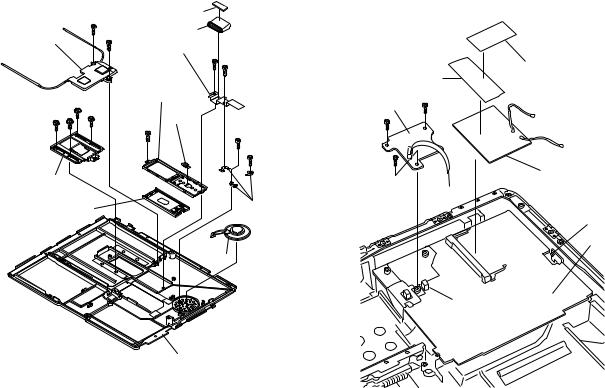
7.1.8.Removing the Speaker
<N> |
LCD Lamp Sheet |
|||
|
|
|||
Heat Pipe Unit |
<N>Coil Cooling Sheet |
|
||
Bottom |
|
LAN Heat |
<M> <M> |
|
|
|
Plate |
||
|
|
MP Eject |
|
|
|
|
BOUSUI |
|
|
<O> |
|
Plate |
|
|
|
MP Eject |
|||
<O> <O> |
||||
|
|
|||
<O> |
|
<P> Spring |
|
|
|
|
<M> |
||
|
|
|
||
|
|
|
<M> |
|
MP Eject |
|
|
|
|
Lever |
|
|
|
|
MP Eject Slide |
|
|
Speaker |
|
Ass’y |
|
|
Angle |
|
Speaker
Bottom Cover
Figure 7
1.Remove the LCD Lamp
2.Remove the four Screws<M>, and remove the LAN Heat Plate, Speaker Angle and the Speaker.
3.Remove the two Screws<N>, and remove the Heat Pipe Unit Bottom.
4.Remove the four Screws<O>, and remove the MP Eject Lever.
5.Remove the Screw<P>, and remove the MP Eject BOUSUI Plate and MP Eject Slide Ass’y.
Screws <M>: DXQT26+D4NLT
Screws <N>: DXYN+J6FNL
Screws <O>: DXYN26+F5NLT
Screw <P>: DXQT26+D4NLT
7.1.9.Removing the Wireless Module and SD PCB
MINI PCI Protector |
CD Edge Sheet |
|
|
Sheet |
|
SD PCB <Q> |
to Connector |
<Q> |
|
|
(CN2) |
|
to Connector |
<Q> |
(CN952) |
|
Wireless Module |
to Connector |
|
(CN56) |
|
|
Connector CN2 |
|
Main PCB |
Connector CN???
Figure 8
1.Disconnect the Cable from Connector (CN2).
2.Remove the Wireless Module.
3.Remove the MINI PCI Protector Sheet and the CD Edge Sheet.
4.Remove the three Screws<Q>.
5.Disconnect the Cable from Connector (CN56).
6.Remove the SD PCB.
Screws <Q>: DFHE5025XA
7-4
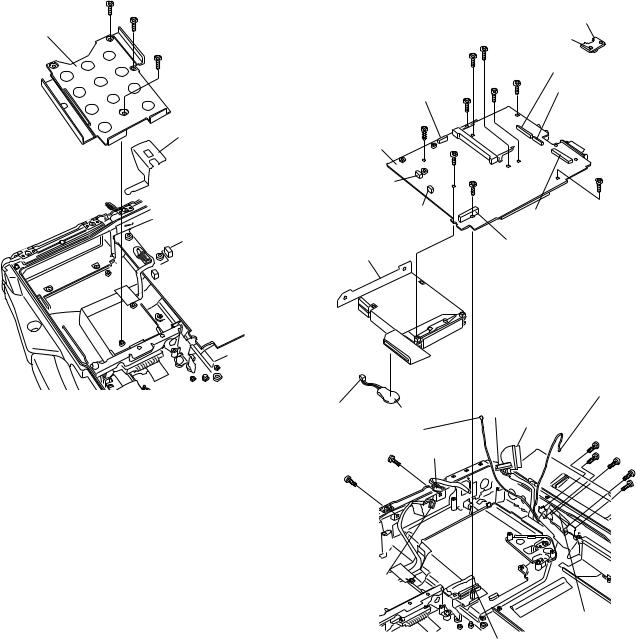
7.1.10. Removing the PAD SW FFC Cover |
7.1.11. Removing Main PCB, EXT Antenna |
||
<R> |
PCB, PCMCIA Unit and RTC Battery |
||
<R> |
|
|
EXT Antenna PCB |
|
|
|
|
PAD SW FFC |
|
<T-2> |
Connector |
Cover |
|
||
<R> |
|
<T-2> |
CN1 |
|
|
Connector CN6 |
|
|
|
<S> |
|
|
|
(reverse side) |
|
|
|
<T-1> |
Connector CN9 |
|
Connector CN51 |
<S> |
(reverse side) |
|
(front side) |
|
|
|
|
|
|
Power Cable |
<T-2> |
|
|
Main PCB |
|
|
|
Guard |
<T-2> |
|
|
|
Connector CN54 |
<W> |
<T-1> |
|
|
||
|
|
|
|
|
(reverse side) |
|
|
|
Connector CN4 |
|
Connector CN10 |
|
(reverse side) |
|
|
|
|
|
(front side) |
|
PCMCIA Unit |
Connector CN1 |
|
|
(reverse side) |
||
Figure 9
1.Remove the three Screws<R>, and remove the PAD SW FFC Cover.
Screws <R>: DFHE5054XA
|
|
|
|
to Connector |
|
|
|
|
(EXT Antenna CN1) |
to Connector |
|
to Connector |
||
|
(CN9) |
to Connector |
||
(CN4) |
RTC Battery |
|
||
|
to Connector |
|
(CN6) |
|
|
|
<U> |
||
|
(CN950) |
to Connector |
|
|
|
<X> |
(CN51) |
|
<U><V> |
<X> |
|
|
|
<V> |
|
|
|
|
|
|
|
|
|
<V> |
to Connector (CN54)
to Connector (CN10)
to Connector (Main PCB CN1)
Figure 10
1.Remove the two Screws<S>.
2.Remove the two Screws<T-1>.
3.Remove the two Screws<U>.
4.Remove the four Screws<V>.
5.Remove the Screw<W>.
6.Remove the two Screws<X>.
7.Disconnect the six Cables from six Connectors. (Main PCB: CN1, CN6, CN9, CN10, CN51, CN54) (EXT Antenna: CN1)
8.Remove the EXT Antenna.
9.Remove the Main PCB.
10.Disconnect the Cable from Connector (CN4).
11.Remove the RTC Battery
12.Remove the four Screws<T-2>, and remove the PCMCIA Unit.
7-5
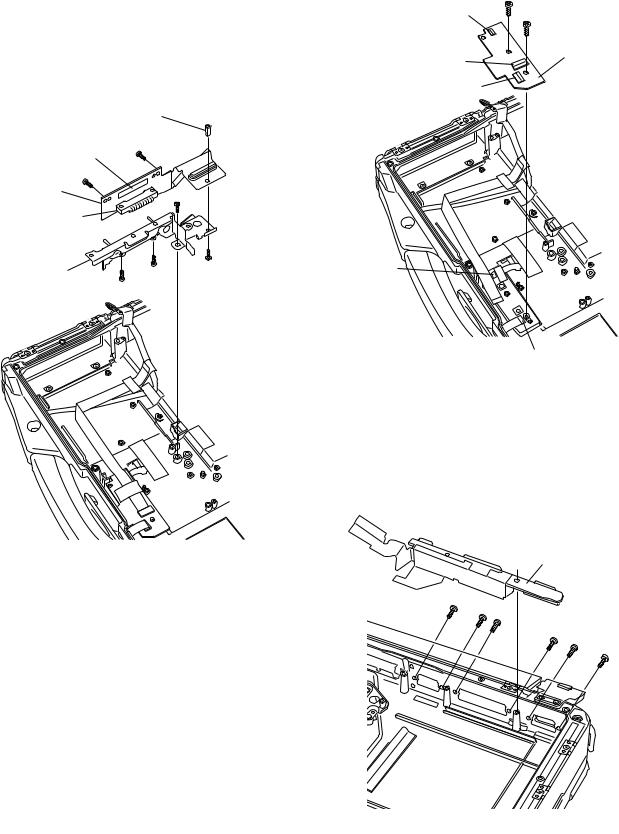
Screws <S>: DFHM5054XA
Screws <T-1>:DFHE5025XA
Screws <T-2>:DFHE5025XA
Screws <U>: DRQT2+G6FKL
Screw <V>: DRHM5104ZA
Screw <W>: DFHE5025ZA
Screw <X>: DRHM5117ZA
7.1.12. Remove the HDD Main FPC
|
CN Spacer |
|
HDD Connector |
<b> |
|
|
|
|
<b> |
|
|
HDD Main |
|
|
FPC |
|
<Y> |
|
|
|
Battery Connector |
|
|
Batt HDD |
<a> |
<Z> |
CN Angle |
|
|
|
|
|
|
<a> |
|
7.1.13. Removing the TP PCB
|
<c> |
Connector CN801 |
<c> |
|
TP PBC
Connector CN800
Connector CN803
to Connector (CN801)
to Connector  (CN800)
(CN800)
to Connector (CN803)
Figure 11
1.Disconnect the three cables from three Connectors. (CN800, CN801, CN803)
2.Remove the two Screws<c>, and remove the TP PCB.
Screws <c>: DRHM0002ZA
7.1.14. Removing the IO PCB
1.Remove the Screws<Y>, and remove the Batt HDD CN Angle.
2.Remove the Screw<Z>, the two Screws<a> and the two Screws<b>.
3.Remove the HDD Main FPC.
Screw <Y>: DFHE5092ZA
Screw <Z>: DFHE5025ZA
Screws <a>: DRHM5104ZA
Screws <b>: DFHE5025XA
IO PCB
<d>
<d> <d>
<d> <d>
<d>
Figure 12
1. Remove the six Screws<d>, and remove the IO PCB.
Screws <d>: DFHE5058ZB
7-6

7.1.15.Removing the Palm Top Cover Sheet, Palm Top Cover, Touch Pad Adhesion Seat, Touch Pad, Touch Pad SW Knob, LED PCB and SW LED PCB
Palm Top Cover Sheet
<e>
7.1.16.Removing the Handle and Power SW
<g>
Handle Base L
Power |
<g> |
SW |
Handle |
|
Handle Base R
<e> |
<e> <e> |
|
<e> Palm Top Cover |
||
|
||
|
Touch Pad Adhesion Seat |
PW LED Sheet
Touch Pad
<f>
PW LED PCB 

LED PCB |
Touch Pad SW Knob |
SW LED |
|
||
|
|
PCB |
Touch Pad
SW Knob In
Figure 15
1.Remove the two Screws<g>, and remove Handle Base L,R.
2.Remove the Handle.
3.Remove the Power SW.
Screws <g>: DRSB4+8FKL
Figure 14
1.Remove the Palm Top Cover Sheet.
2.Remove the five Screws<e>, and remove Palm Top Cover.
3.Remove the Touch Pad Adhesion Seat.
4.Remove the Touch Pad.
5.Remove the Touch Pad SW Knob and Touch Pad SW Knob In.
6.Remove the LED PCB.
7.Remove the PW LED Sheet.
8.Remove the Screw<f>, and remove the SW LCD PCB.
Screws <e>: DRHM0002ZA
Screw <f>: DRHM0002ZA
7-7

7.1.17. Removing LCD Unit
LCD unit
<i><i>
<i><i>
<h>

 <h>
<h>
Figure 16
1.Remove the two Screws<h> and the four Screws<i>, and remove the LCD Unit.
Screws <h>: DXSB4+12FNLB
Screws <i>: DXYN4+J8FNL
7.1.18.Removing LCD Rear Cabinet, Hinge L and Hinge R
|
|
<k><j> |
|
|
<k> |
|
<k> |
|
<k> |
|
<k> |
|
|
<j><k> |
|
<k> |
|
|
|
<k> |
|
|
|
|
|
|
|
|
|
<k> |
<k> |
|
|
|
|
|
|
<k> |
<k> |
|
|
|
LCD Latch 
<l> |
LCD Rear Cabinet |
Hinge L
Hinge R
<l>
LCD Front Cabinet
Figure 17
1.Remove the two Screws<j> and the twelve Screws<k>, and remove the LCD Rear Cabinet.
2.Remove the LCD Latch.
3.Remove the two Screws<l>, and remove the Hinge L and R.
Screws <j>: DRSB4+10FKL
Screws <k>: DRSB26+8HKL
Screws <l>: DRHM0062ZA
7-8

7.1.19.Removing the Inverter PCB, TS PCB and LCD Unit
Inverter PCB |
TS PCB |
LCD Unit
LCD Front Cabinet
Figure 18
1.Disconnect two Cables from Connectors. (on Inverter PCB)
2.Remove the Inverter PCB.
3.Disconnect two Cables from Connectors. (on TS PCB)
4.Remove the TS PCB.
5.Remove the LCD Unit.
7.1.20.Removing the Antenna PCB L and R
Antenna PCB Cover L
LCD Rear Cabinet Ass’y
Antenna PCB L
<m>
<m>
<m>
<m>
Antenna PCB R Antenna PCB Cover R
Figure 19
1.Remove the four Screws<m>.
2.Remove the Antenna PCB Cover L and R and Antenna PCB L and R.
Screws <m>: DRSB26+8KL
7-9
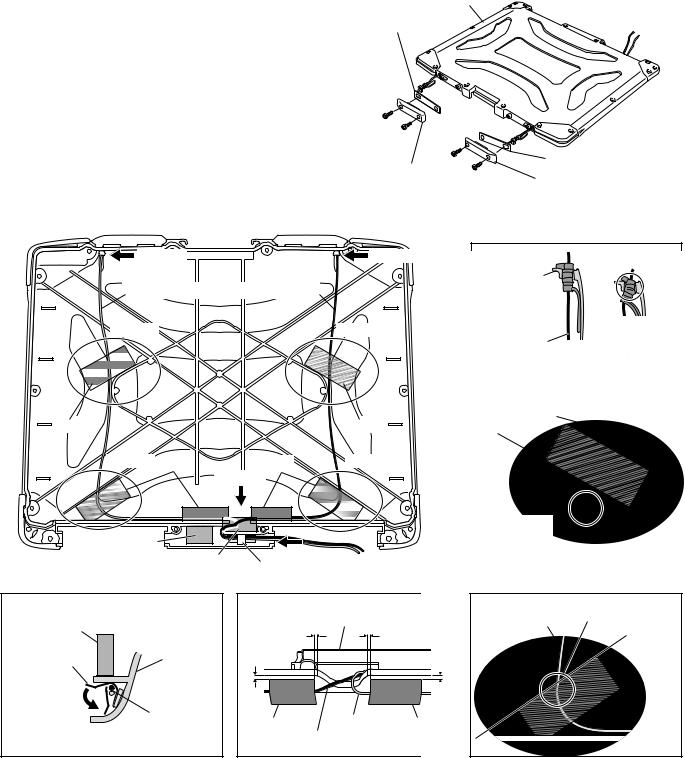
7.2.Reassembly Instructions
7.2.1.Attention when CF-29 series is repaired
•Please execute writing BIOS ID when you exchange the Main Board.
•You cannot reuse the Conductive Clothes and the heat dissipating parts such as Sheet and Rubber. Use new parts.
7.2.2.Setting the Antenna PCB L and R
1.Set the Antenna PCB L and R to the LCD Rear Cabinet Ass’y.
2.Fix the Antenna PCB Cover L and R using the four Screws. <i>
Screws <m>: DRSB26+8KL
■ Arranging the Antenna L and R Cables
LCD Rear Cabinet Ass’y
Antenna PCB L
<m>
<m> |
|
|
|
Antenna PCB |
<m> |
Antenna PCB R |
|
Antenna PCB Cover R |
|||
Cover L |
<m> |
View "A"
View "A" |
View "A" |
|
<No good> |
|
|
|
|
||
|
|
LCD Rear |
|
|
Antenna Cable L |
Antenna Cable R |
Cabinet |
|
|
|
|
|||
View "B" |
View "B" |
|
Do not press too |
|
Antenna |
much the |
|||
|
|
|||
|
|
Waterproof Cap. |
||
|
|
Cable |
||
|
|
|
|
|
|
View "B" |
|
|
|
Antenna Cable R |
Tape |
|
Tape |
Tape |
View "C" Tape |
Tape |
View "C" |
|
View "D" |
|
|
|
|
|
|
align |
|
|
|
Pass the Antenna |
Cushion |
|
|
Cable through this |
|
|
space. |
|
|
View "E" |
|
|
Waterproof Cushion |
|
|
|
Cable Clamper |
|
|
|
View "E" |
View "D" |
Waterproof |
|
|
LCD Rear Cabinet |
|
|
1~5mm |
1~5mm |
|
|
Cushion |
|
|
||
|
LCD Rear |
|
|
|
Cable Clamper |
Cabinet |
1~4mm |
|
1~4mm |
Bend |
|
|
|
|
|
Antenna Cable |
Tape |
Antenna Cable L |
Tape |
|
L and R |
|||
|
|
|
|
|
|
|
Antenna Cable R |
|
|
View "C"
Pass the Antenna Cable |
through this space. |
Antenna Cable L |
align |
Tape |
7-10

7.2.3.Setting the Inverter PCB, TS PCB and LCD Unit
1.Set the LCD Unit to the LCD Front Cabinet in order.
2.Attach the Inverter PCB to the LCD Unit and connect the two Cables to the two Connectors on the Inverter PCB.
3.Attach the TS PCB to the LCD Unit in order and connect the two Cables to the two Connectors on the TS PCB.
View "A"
Safty Working
TS PCB
3  4
4
LCD Unit
Connectors Connectors
TS PCB
Inverter PCB
View "A"
LCD Unit
 2
2
 1
1
LCD Front Cabinet
■Attaching the Touch Screen Panel.
1.Attach the Touch Screen Panel to the LCD Front Cabinet using the TS Tape.
Note:
Use extreme caution when handling the Touch Screen Panel to avoid damage, fingerprints, etc.
|
|
|
|
|
View "A" |
|
|
View "A" |
||||
|
|
|
|
|
|
|
|
|
|
|
|
Touch Screen Panel |
|
|
|
|
|
|
|
|
|
|
|
|
|
|
|
|
|
3±1mm |
|
|
TS FPC Spacer |
|||||
|
|
|
|
0±0.5mm |
||||||||
|
|
|
|
|
|
|
||||||
|
|
|
|
|
|
|
||||||
|
|
|
|
|
|
|
|
|
|
|
|
|
|
|
|
|
|
|
|
|
|
|
|
|
|
|
|
|
|
|
|
|
|
|
|
|
|
|
TS FPC Spacer
TS FPC
TS Tape
View "B"
LID Magnet |
Forming Unit |
0~1mm |
LCD Front Panel |
TS FFC Sheet
View "B"
Forming Unit
LID Magnet
LCD Front Cabinet
7-11
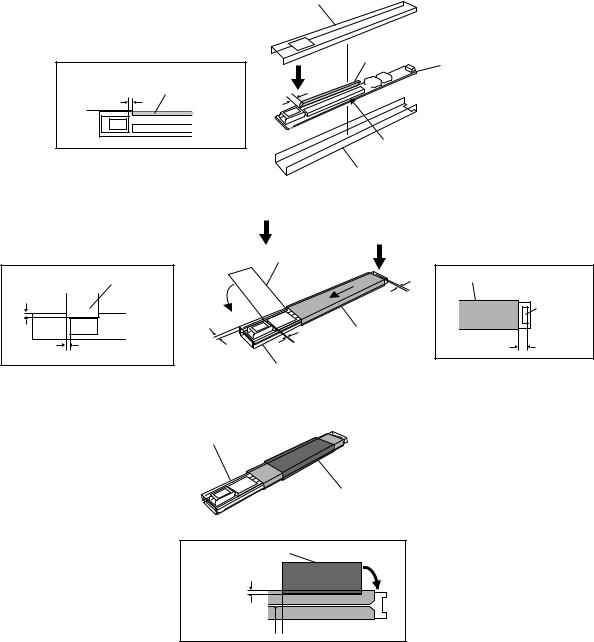
■Arranging the Inverter PCB
1.Attach the LCD Inverter Case Spacer L to the Inverter PCB.
2.Attach the Inverter Case L/U to the Inverter Case L.
|
|
Inverter Case U |
|
View "A" |
LCD Inverter Case |
||
Spacer L |
Inverter PCB |
||
|
LCD Inverter Case |
View "A" |
|
|
|
||
1~2mm |
Spacer L |
1~2mm |
|
|
|
||
Align |
|
|
|
|
|
|
|
|
|
Do not pressure to trance circuit. |
|
|
|
Inverter Case L |
|
3. Attach the LCD Inverter Case Tape and the Inverter Shield to the Inverter Case.
|
View "B1" |
|
|
|
View "B1" |
|
LCD Inverter Case Tape |
View "B2" |
View "B2" |
LCD Inverter Case Tape |
|
|
|
Inverter Shield |
0~3mm |
|
|
0~1mm |
Connector |
|
|
|
|
|
|
0~3mm |
|
Inverter Shield |
|
|
0~2mm |
|
0~1mm |
|
0~2mm |
|
|
||
|
Inverter Case |
|
|
|
|
|
|
|
|
4. Attach the Inverter Shield Tape to the Inverter Case.
Inverter Case
 Inverter Shield Tape
Inverter Shield Tape
View "C"
View "C"
Inverter Shield Tape
0~1mm

 0~2mm
0~2mm
7-12
